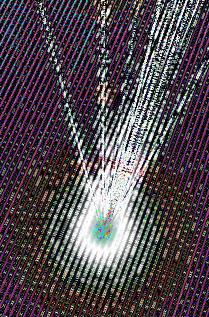Light sheets to illuminate new chips
 Engineers have developed a new way to turn electricity into light.
Engineers have developed a new way to turn electricity into light.
When an aeroplane exceeds the speed of sound, it creates a booming shockwave. MIT researchers say they have discovered a similar process when electricity hits a sheet of graphene - a two-dimensional form of the element carbon.
Their experiments show that a flow of electric current can, under certain circumstances, exceed the speed of slowed-down light and produce a kind of optical “boom”: an intense, focused beam of light.
This entirely new way of converting electricity into visible radiation is highly controllable, fast, and efficient, the researchers say, and could lead to a wide variety of new applications.
“Graphene has this ability to trap light, in modes we call surface plasmons,” explains Ido Kaminer, the lead author of the study.
Plasmons are a kind of virtual particle that represent the oscillations of electrons on the surface.
The speed of these plasmons through the graphene is “a few hundred times slower than light in free space,” Kaminer says.
The surface effect fits with another of graphene’s exceptional characteristics: Electrons pass through it at very high speeds, up to a million meters per second, or about 1/300 the speed of light in a vacuum.
This means that the two speeds are similar enough that significant interactions can occur between the two kinds of particles, if the material can be tuned to get the velocities to match.
“The electronic speed can approach the light speed in graphene, breaking the ‘light barrier’,” says researcher Marin Soljačić.
Just as breaking the sound barrier generates a shockwave of sound, he says, “in the case of graphene, this leads to the emission of a shockwave of light, trapped in two dimensions”.
Graphene is some weird stuff, and its newfound ability to slow down light while allowing electrons to move very fast only adds to its many unusual properties.
There are a lot of ways to convert electricity into light — from heated tungsten filaments of the 19th century, to fluorescent tubes, to the light-emitting diodes (LEDs) of today.
This new plasmon-based approach might eventually be part of more efficient, more compact, faster, and more tunable alternatives for certain applications, the researchers say.
They say graphene-based systems could one day be used for on-chip components in the creation of new, light-based circuits, which are considered a major new direction in the evolution of computing technology toward ever-smaller and more efficient devices.







 Print
Print